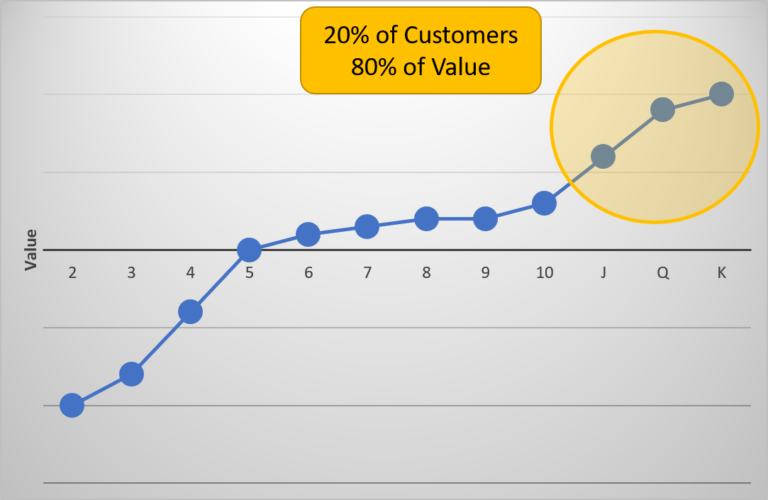
Choosing your Customers
Two weeks ago we kicked off our Monthly FREE Webinar series with a discussion of the most important aspect in any business – your customers! This post recap’s some of the key concepts we discussed.
To seriously consider the topic of choosing customers the first useful insight is that not every customer is the same. In fact it’s very likely that you have a range of different customers and as you may have hundreds of customers it probably makes sense to think about customers in categories.
To help the process of categorising customers I’m going to introduce a simple tool – a pack of playing cards. Only we won’t use all of the cards, just a single suit (I selected diamonds for discussion).
You might do what I did and leave out the Aces since we are going to think about value, and they can be both high and low. That leaves us with 12 cards to consider – definitely enough categories for most businesses.
Creating twelve categories isn’t the only reason for using playing cards – most of us intrinsically assign value to each of the cards, and that’s a key part of the process we recommend:
- Your highest value customers are represented by the picture cards. These are the customers that you are hoping for every time someone approaches your business, and often you are already trying to provide special treatment to them.
- Your least valuable customers are the small cards – the two’s and three’s are often taking value out of your business (costing you every time you work with them). Sometimes this extends to the four’s and five’s as well!
- In the middle are the bulk of your customers – probably 60% or more of them.
As I said we often try to give special treatment to the high value customers, but it’s just as likely that we’re accidentally working really hard for less valuable customers and sacrificing the way that we service the more valuable customers.
For example, a restaurant may choose to overload it’s service staff on busy nights to try to make up for the cost of being open when it’s quiet – accidentally punishing the valuable Saturday night diner who is happy to spend two or three times a Tuesday night customer if they get great service.
One thing that’s worth pointing out is that value doesn’t have to represent financial value, sometimes as a business owner you are looking to grow in an area knowing that the financial return isn’t the only factor.
Even when your lens is financial it’s important to distinguish between revenue and profit. High paying customers tend to have higher expectations that make them more expensive to service.
When you’re clear about the value of each customer group you can arrange them in order, just like you would sort the suit of cards. If you graph the customers it’s likely they will look something like the chart below:

In 1896 Italian economist Vilfredo Pareto noted that approximately 80% of the land in Italy was owned by 20% of the population. This is now known as The Pareto Principle (or the 80/20 rule).
Through the years, the validity of his principle has been proven beyond debate. As a general rule and across different industries, 20% of customers deliver 80% of the value, 20% of the team do 80% of the work, 20% of the products deliver 80% of the sales, and 80% of your outcomes comes from 20% of your input.
Considering the whole graph above and all of the customers we can establish three clear strategies that could be applied in response:
- We can apply the Pareto Principle to the top of the curve (as is shown in the diagram above) by actively focussing our attention on the ‘picture cards’ – both looking to acquire more high value customers and ensuring that they are carefully looked after.
- We can apply the Pareto Principle to the bottom of the curve, based on the premise that 20% of your customers most likely cost you 80% of your effort – the are likely to be the 2’s, 3’s and 4’s. From a strategy perspective you could be bold and FIRE these customers or you could be more subtle and change the service offering for these customers. A couple of decades ago I worked for one of Australia’s largest organisations who were actively ‘firing’ these customers by encouraging them to buy from resellers instead of being direct customers.
- The third option is to attempt to increase the value in the middle of the curve, and is an option that I’ve personally pursued in a business of my own. In this case only the ‘picture cards’ were profitable due to the highly competitive nature of the industry the business was in. Although I was able to make gains in value, if I had the same choice to make again this would be the last strategy I would pursue.
When deciding what to do in your business it’s not only important to have a conscious strategy for how you are engaging customers, it’s also important to focus on a limited number of strategies at a time (often you’ll be most effective when focussing on a single strategy).
This month we’ll be continuing our FREE Webinar series with a session on Bringing your Strategy to Life.
In the meantime if you want help with your strategy for Choosing your Customers then reach out to book a free 30 minute consultation with Ascend at info@ascend.business.
